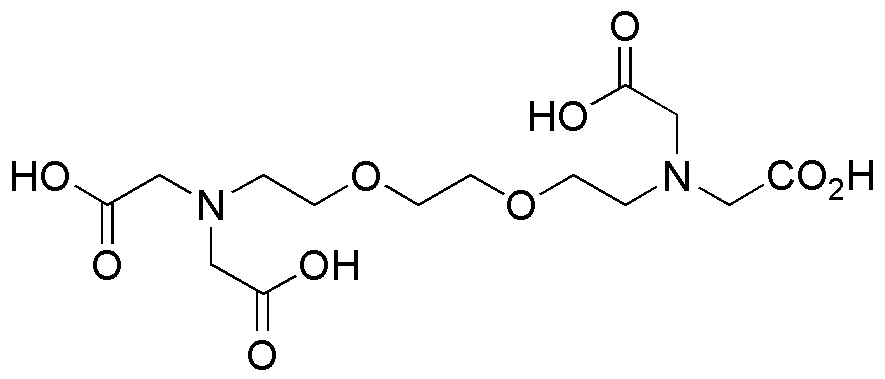Ethylene glycol-bis(b-aminoethyl ether)-N,N,N',N'-tetraacetic acid is widely utilized in research focused on:
- Metal Ion Chelation: This compound effectively binds metal ions, making it valuable in applications such as water treatment and metal recovery processes, where removing unwanted metals is crucial.
- Biomedical Applications: Its chelating properties are beneficial in drug formulation and delivery systems, particularly for targeting specific metal ions in therapeutic contexts, enhancing drug efficacy.
- Analytical Chemistry: Used as a reagent in various analytical techniques, it aids in the detection and quantification of metal ions in complex samples, improving the accuracy of results.
- Research in Biochemistry: This compound serves as a tool for studying metal-dependent enzymes, helping researchers understand enzyme mechanisms and develop inhibitors for therapeutic purposes.
- Environmental Remediation: Its ability to sequester heavy metals makes it a key player in environmental cleanup efforts, particularly in contaminated water bodies, promoting safer ecosystems.
General Information
Properties
Safety and Regulations
Applications
Ethylene glycol-bis(b-aminoethyl ether)-N,N,N',N'-tetraacetic acid is widely utilized in research focused on:
- Metal Ion Chelation: This compound effectively binds metal ions, making it valuable in applications such as water treatment and metal recovery processes, where removing unwanted metals is crucial.
- Biomedical Applications: Its chelating properties are beneficial in drug formulation and delivery systems, particularly for targeting specific metal ions in therapeutic contexts, enhancing drug efficacy.
- Analytical Chemistry: Used as a reagent in various analytical techniques, it aids in the detection and quantification of metal ions in complex samples, improving the accuracy of results.
- Research in Biochemistry: This compound serves as a tool for studying metal-dependent enzymes, helping researchers understand enzyme mechanisms and develop inhibitors for therapeutic purposes.
- Environmental Remediation: Its ability to sequester heavy metals makes it a key player in environmental cleanup efforts, particularly in contaminated water bodies, promoting safer ecosystems.
Documents
Safety Data Sheets (SDS)
The SDS provides comprehensive safety information on handling, storage, and disposal of the product.
Product Specification (PS)
The PS provides a comprehensive breakdown of the product’s properties, including chemical composition, physical state, purity, and storage requirements. It also details acceptable quality ranges and the product's intended applications.
Certificates of Analysis (COA)
Search for Certificates of Analysis (COA) by entering the products Lot Number. Lot and Batch Numbers can be found on a product’s label following the words ‘Lot’ or ‘Batch’.
*Catalog Number
*Lot Number
Certificates Of Origin (COO)
This COO confirms the country where the product was manufactured, and also details the materials and components used in it and whether it is derived from natural, synthetic, or other specific sources. This certificate may be required for customs, trade, and regulatory compliance.
*Catalog Number
*Lot Number
Safety Data Sheets (SDS)
The SDS provides comprehensive safety information on handling, storage, and disposal of the product.
DownloadProduct Specification (PS)
The PS provides a comprehensive breakdown of the product’s properties, including chemical composition, physical state, purity, and storage requirements. It also details acceptable quality ranges and the product's intended applications.
DownloadCertificates of Analysis (COA)
Search for Certificates of Analysis (COA) by entering the products Lot Number. Lot and Batch Numbers can be found on a product’s label following the words ‘Lot’ or ‘Batch’.
*Catalog Number
*Lot Number
Certificates Of Origin (COO)
This COO confirms the country where the product was manufactured, and also details the materials and components used in it and whether it is derived from natural, synthetic, or other specific sources. This certificate may be required for customs, trade, and regulatory compliance.

